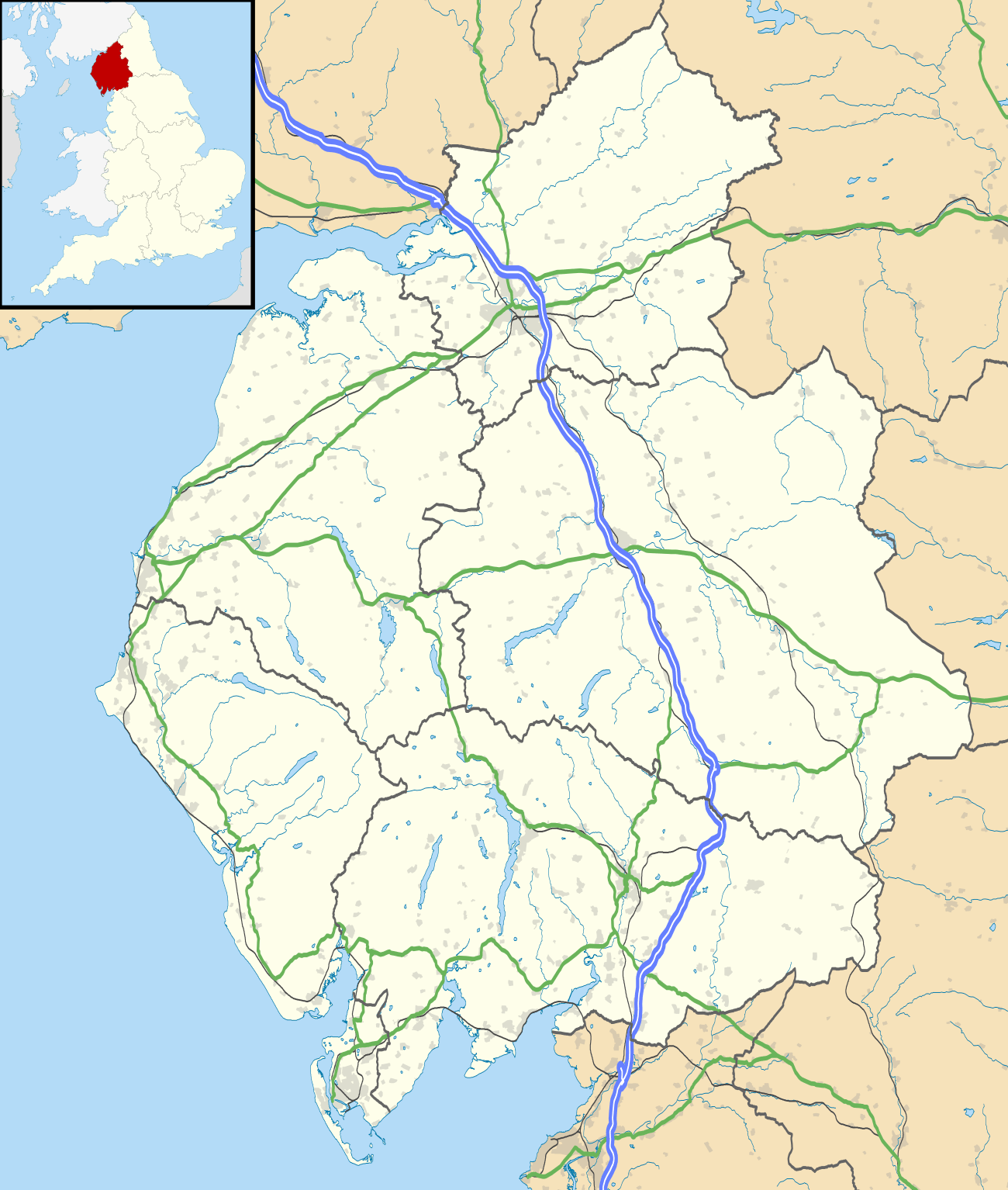Kirkby Thore
| Kirkby Thore | |
|---|---|
May2005.jpg) Kirkby Thore Gypsum Plant | |
 Kirkby Thore Kirkby Thore shown within Cumbria | |
| Population | 758 (2011)[1] |
| OS grid reference | NY639257 |
| Civil parish |
|
| District | |
| Shire county | |
| Region | |
| Country | England |
| Sovereign state | United Kingdom |
| Post town | PENRITH |
| Postcode district | CA10 |
| Dialling code | 017683 |
| Police | Cumbria |
| Fire | Cumbria |
| Ambulance | North West |
| EU Parliament | North West England |
| UK Parliament | |
Kirkby Thore is a small village, civil parish and hill in Cumbria, England at grid reference NY639257. It is close to the Lake District national park and the Cumbrian Pennines. The market town of Appleby-in-Westmorland is about 5 miles away, and the larger town of Penrith is about 8 miles away. It is in the historic county of Westmorland.
History
The place-name 'Kirkby Thore' is first attested in 1179 in the 'Register of Holm Cultram', where it appears as Kirkebythore. Kirkby means 'church village' or 'village with a church', whilst Thore is an Old Norse personal name related to the god Thor.[2]
The village is on the site of a Roman cavalry camp called Bravoniacum[3] or Brovonacae[4] and Roman coins, tombstones, sandals, urns, earthen vessels, and the cusp of a spear have been found in the locality. The Maiden Way Roman road led north from Bravoniacum to Epiacum (Whitley Castle), and thence to Magnae (Carvoran) on Hadrian's Wall, where it joined the Stanegate road running from west to east. A continuation from there ran east to Banna (Birdoswald) and then 7 mi (11 km) north to the Shrine of Cocidius (Bewcastle). It was reported in 2016 that LIDAR technology has revealed another Roman road running southwest from Kirkby Thore to the Roman fort at Low Borrowbridge near Tebay.[5]
The Anglican church of St Michael in Kirkby Thore is built of red sandstone and dates from Norman times. The village also has a Methodist chapel.
Gypsum has been quarried or mined in the area for over 200 years. The local British Gypsum Ltd[6] plant has produced plaster since 1910 and plasterboard since the 1960s. Currently it is more economic to use desulpho-gypsum transported by rail from Drax Power Station than to mine it locally but this depends on Drax continuing.[7] British Gypsum has a private siding on the Settle-Carlisle Railway which passes to the north of the village.
Governance
An electoral ward of the same name exists. This ward stretches west to Mallerstang with a total population of 1,563.[8]
Transport and facilities
The busy A66 road runs through the western edge of the village. This will be one of the last sections of the A66 to be upgraded to dual carriageway; in 2006 the Highways Agency conducted public consultation on the route for a bypass (which will connect the existing Appleby bypass to the east and the Temple Sowerby bypass (opened in part October 2007, ahead of schedule) to the west. The public consultation fell by the wayside and dualling of the A66 at Kirkby Thore is still an aspiration.
The village contains a village shop with post office, a BP filling station (and shop) and a Bistro serving meals.
Notable people
Siblings Helen Skelton and Gavin Skelton grew up in a farm near the village and attended Kirkby Thore Primary School before transferring to Appleby Grammar School. Helen is now a television presenter, best known for working on Blue Peter and Countryfile, whilst Gavin is a professional footballer who has played in the Scottish Premier League with Gretna, Kilmarnock and Hamilton Academicals. In 2016 he was made player-manager of Queen of the South in Dumfries.
See also
References
- ↑ "Parish population 2011". Retrieved 21 June 2015.
- ↑ Eilert Ekwall, The Concise Oxford Dictionary of English Place-names, p.280.
- ↑ "Kirkby Thore". The Cumbria Directory. 2006. Retrieved 2006-10-26.
- ↑ John Horsley (1732). Britannia romana. John Osborn & Thomas Longman. p. 410.
- ↑ "Lasers reveal 'lost' Roman roads". Environment Agency. 3 February 2016.
- ↑ "Kirkby Thore". British Gypsum. 2010. Retrieved 2010-10-07.
- ↑ "Pre-submission Consultations Statement on Sites Allocations Policies" (PDF). Cumbria County Council. 2010. p. 4.
- ↑ "Ward population 2015". Retrieved 21 June 2015.
External links
| Wikimedia Commons has media related to Kirkby Thore. |
- Highways Agency page on the possible Kirkby Thore bypasses.
- Cumbria County History Trust: Kirkby Thore (nb: provisional research only - see Talk page)